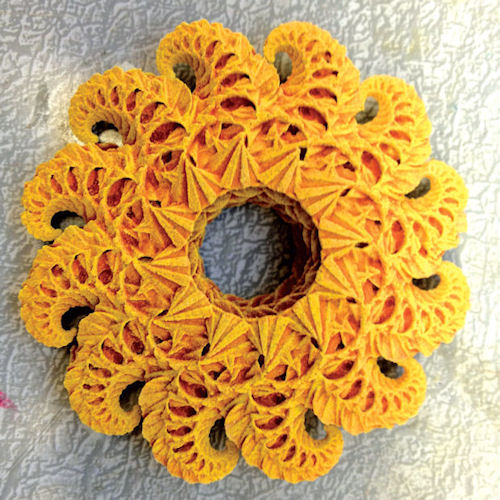
Swirled ceramic artwork 3D-printed with Tethon3D powder, then glazed and fired. Tethon3D specializes in converting standard ceramic powders into 3D-printable ceramic powders that are highly receptive to glazing. Image courtesy of Tethon3D.
Latest News
October 1, 2014
 Swirled ceramic artwork 3D-printed with Tethon3D powder, then glazed and fired. Tethon3D specializes in converting standard ceramic powders into 3D-printable ceramic powders that are highly receptive to glazing. Image courtesy of Tethon3D.
Swirled ceramic artwork 3D-printed with Tethon3D powder, then glazed and fired. Tethon3D specializes in converting standard ceramic powders into 3D-printable ceramic powders that are highly receptive to glazing. Image courtesy of Tethon3D.There was a time when a big year in 3D printing saw the announcement of three or four new materials across the five or six major players. With fundamental patents recently expiring, and general interest growing, materials development for both professional/consumer systems (open source) and industrial systems (classic equipment companies) is at a record pace.
In fact, the 3D printing materials market is predicted to be worth more than $600 million by 2025 (Source: MarketResearchReports.biz, “3D Printing Materials 2014-2025: Status, Opportunities and Market Forecasts”).
With so much going on, DE is compiling a two-part update. This article highlights the extensive variety of newer non-metal options, while our November issue will focus on the increasing variety of metal-based materials.
Where to Begin?
Powders, pellets, pastes, liquids and filaments—these are the vocabulary words that give form and substance to most non-metal 3D printing materials. Within each category, the base chemistry may be nylon, ceramic, acrylonitrile butadiene styrene (ABS) plastic, polylactic acid (PLA), photo-curable resin or more. The results may be flexible, clear, colored, recyclable, fire-retardant, wax-like, glow-in-the-dark or reinforced. (Spoiler alert: Read on to learn about long-awaited options for 3D printing with carbon fiber, carbon nanotubes and graphene, from MarkForged, Arevo Labs and Graphene 3D Lab.)
Resins
As a nod to the origins of 3D printing, we start with photocurable resins, the kind first used by 3D Systems in its groundbreaking 355nm-laser-based stereolithography (SL) equipment. Envisiontec and others apply digital light processing (DLP) light sources to solidify similar types of resins.
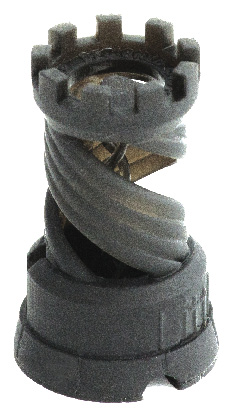 Classic chess rook piece 3D-printed in the improved (finer detail, less clouding) Black MS UV-curable SL resin from MadeSolid. The company also produces extrusion filament. Image courtesy of MadeSolid.
Classic chess rook piece 3D-printed in the improved (finer detail, less clouding) Black MS UV-curable SL resin from MadeSolid. The company also produces extrusion filament. Image courtesy of MadeSolid.Ultraviolet light (UV)-sensitive resins also work in Stratasys PolyJet systems (including the Connex digital material system) and 3D Systems’ ProJet MultiJet Printing systems, both of which “jet” and cure fine droplets from ink-jet-type printer heads. Keep in mind that not all resins work in all systems, and many systems require use of the company’s proprietary materials (although some workarounds exist).
In March, Envisiontec announced EPIC, a dark green wax-based casting material; resulting parts display the crisp edges of the company’s polyisocyanurate (PIC) material with the good burn-out properties of its EC-500. Additional resins for Envisiontec systems are now available from DeltaMed, a supplier that was bought in April by Groupe Gorgé, the French manufacturer that now owns Prodways. Prodways offers three systems based on its MOVINGLight Digital Light Processing (DLP) technology—including the K20 Producer system, which can cure highly viscous ceramic pastes.
Addressing the newer 365nm operational wavelength of today’s LED and DLP systems, the Somos line from Royal DSM now includes ProtoGen Clear 365nm, featuring excellent transparency, accuracy and high temperature resistance (characteristics very similar to those of Somos ProtoGen SL materials). The company also markets 355/365nm versions of the durable PerFORM tooling composite with improved viscosity and faster build-times.
Both patent-expiration and crowd-sourcing have inspired a new world of photopolymer-resin-based 3D printing systems such as FormLabs Form1, Old World Labs (OWL) Nano, B9Creations B9Creator, FSL3D Pegasus Touch, DWSLab XFAB, Uncia 3D, MAKEX M-One, Hardcotton Elemental, Stalactite 102 and Peachy Printer. Although perhaps initially more oriented toward prosumer and professional (rather than industrial) applications, these systems are important to track. They are driving the development of equipment and resins geared to a wide range of system types, end uses and budgets.
In support of these efforts, independently crafted materials have been mushrooming. Some online sources provide a great deal of information about the relevant chemistry, properties and applications. Some offer lively insights to their team’s backgrounds and efforts; others seem very, very private. Check out these manufacturers and their materials: MakerJuice (UV resins for many consumer systems, plus pigments), Spot-A Materials (hard-tough, general-purpose, low-viscosity and elastic resins), Bucktown Polymers (UV, visible light and infrared, or IR, polymer resins), 3D Ink (orange and clear resins) and MadeSolid (lower-viscosity MS Resin, durable orange or yellow MS Tough Resin and no-ash MS FireCast Resin).
Other Liquid/Semi-liquid Materials
Options keep coming for jetted photopolymers, used by Stratasys and its Solidscape systems as well as 3D Systems. The big news this year from Stratasys was the expanded palette of colors and flexibilities for the Objet500 Connex3 Multi-material 3D printer; Stratasys also introduced VeroGlaze dental material and the flexible, polypropylene-like Endur material, for the appropriate Objet systems.
Blended colors and materials are now available in a new line of 3D Systems VisiJet 5500X materials, which can be mixed together two materials at a time in the company’s ProJet 5500X system. By combining multiple materials in a single build, the system creates parts with composites that combine black rubber-like, white rigid ABS-like and clear polycarbonate-like materials.
Powders
Instead of liquid resins, two more major 3D printing technologies—sintering and ink-jet—use powdered materials in very different ways. Each category is then sub-divided, the former according to power source (UV laser or light source) and the latter by binder and material types.
For almost two decades, 3D Systems and EOS have dominated the world of thermoplastic laser-sintering; last year EOS introduced two new materials, the rubber-like PrimePart ST and the flame-retardant PrimePart FR (a flame-retardant polyamide 12). Over time, though, other independent companies such as CRP Technology, Taulman3D, Arkema and Advanced Laser Materials (ALM) have joined the field, introducing dozens of material options. For example, ALM, now a division of EOS, specializes in custom LS thermoplastics such as carbon composites, optimized to meet new additive manufacturing (AM) material requirements.
Traditionally, adding carbon fibers to dry powders forms parts whose stiffness is good in the X direction, less in the Y direction, and a 40% to 60% loss in the Z direction. ALM has developed a process that compounds carbon fibers and resins into pellets that are then ground into a powder for LS. The resulting material, though containing shorter fibers, displays stiffness values of just 10% variation among X, Y and Z directions. These new isotropic materials based on polyetherketoneketone (PEKK) and Polyamide 11 (PA11), have been developed for the next generation of the Boeing 777Xs. The Lotus F1 design team is currently using them.
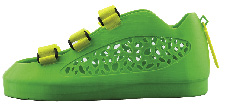 Flexible, colorful shoes made on an extrusion printer with Fenner Drives’ NinjaFlex filament, available in eight colors plus semi-transparent. Image courtesy of Fenner Drives.
Flexible, colorful shoes made on an extrusion printer with Fenner Drives’ NinjaFlex filament, available in eight colors plus semi-transparent. Image courtesy of Fenner Drives.Current projects include the development of PEKK materials that process at lower temperatures than the currently available polyetheretherketone (PEEK), resulting in a more recyclable product to save processing time and to lower the cost.
In the ink-jet realm, 3D Systems now offers a powdered plastic material, VisiJet C4 Spectrum, that runs on the new full color ProJet 4500 plastic printer. This is the first new material for any printer in this family in about 15 years, producing more durable parts than those made of the classic plaster-like gypsum.
Tethon 3D is a small company with an artistic slant, and eight years of experience with ceramic materials for 3D printing. Specially formulated Tethonite ceramic (clay) powders are available as earthenware, stoneware and porcelain formulations. Along with liquid binders, they are optimized for use on any powder-based ink-jet 3D printer. Tethon 3D also sells thousands of glazes that work specifically with their powders. (Emerging Objects, a creative architectural firm, continues to develop diverse new materials for 3D Systems equipment based on cement, salt, wood and paper, but does not currently offer them for sale.)
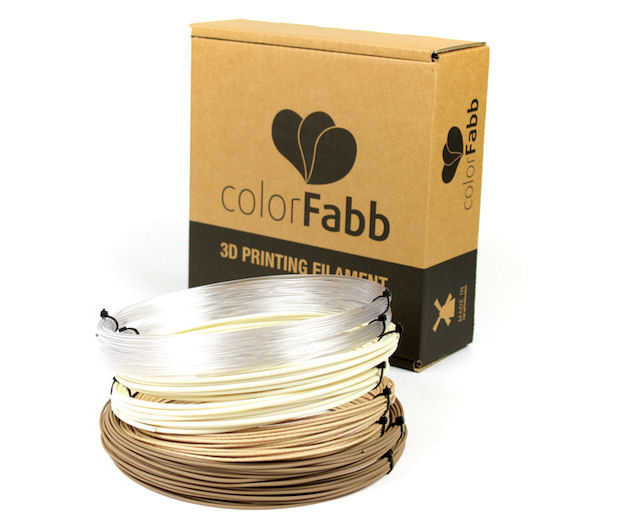 Samples of woodFill, bronzeFill and glowFill filaments from ColorFabb, for extrusion 3D printing systems. Image courtesy of ColorFabb.
Samples of woodFill, bronzeFill and glowFill filaments from ColorFabb, for extrusion 3D printing systems. Image courtesy of ColorFabb.Filament
Much less expensive than UV resins, and seemingly infinitely adaptable, are materials for filament-based printers. Whether loaded into traditional Fused Deposition Modeling (FDM) systems from Stratasys or fed to any one of the 50-plus variations based on the RepRap open-source system, filament is very popular product; an entire sub-genre has even emerged of make-your-own-filament equipment suppliers.
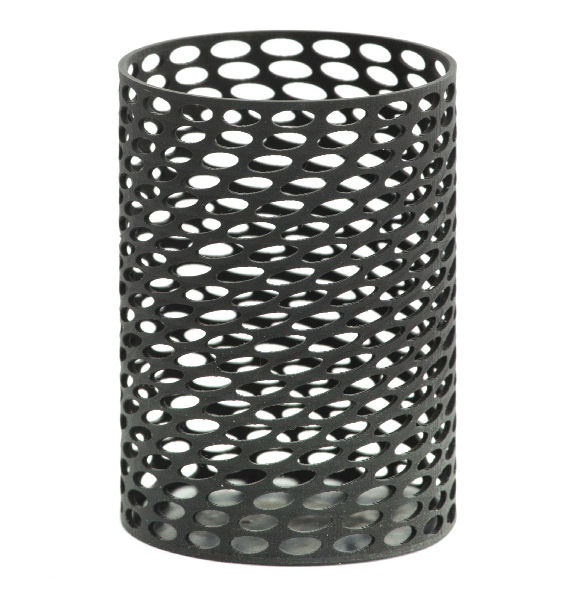 Artistic cylinder design 3D-printed with the improved (finer detail, less clouding) Black MS SL resin from MadeSolid. The company also produces extrusion filament. Image courtesy of MadeSolid.
Artistic cylinder design 3D-printed with the improved (finer detail, less clouding) Black MS SL resin from MadeSolid. The company also produces extrusion filament. Image courtesy of MadeSolid.Obviously, Stratasys offers dozens of FDM filaments. But over the years, enterprising businesses such as Bolson Materials have also developed substitute materials—and the EEPROM ID chips that allow many Stratasys systems to operate with non-OEM material cartridges. Bolson offers custom color-matching, as well as a Monster Green glow-in-the-dark ABS, and is working on compatible materials for the Stratasys uPrint systems.
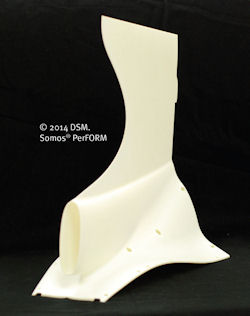 Prototype racecar part made with DSM Somos PerFORM nano-particle-filled SL resin. The stiffness and heat resistance make it well suited for motor-sports wind tunnel testing of parts that will later be made from carbon fiber composites. PerFORM can also be used for non-load-bearing end-parts on the same type of cars. Image courtesy of DSM Somos.
Prototype racecar part made with DSM Somos PerFORM nano-particle-filled SL resin. The stiffness and heat resistance make it well suited for motor-sports wind tunnel testing of parts that will later be made from carbon fiber composites. PerFORM can also be used for non-load-bearing end-parts on the same type of cars. Image courtesy of DSM Somos.Also this year, Taulman3D, a two-year-old manufacturer, commercialized its high-strength, low-temperature t-glase (tee-glass) filament for 3D printers that run low-temperature PLA filament.
ColorFabb, a Dutch filament producer founded last year, offers a PLA blended with polyhydroxyalkanoate (PHA), a bio-polyester, for added strength; the material is available in 29 solid or transparent colors plus custom colors. The company recently announced the availability of glow-in-the-dark glowFill, PLA Bronze, bambooFill and woodFill, and sells pellet sources of PLA/PHA, PLA, XT-CoPolyester and woodFill to users with extruders for DIY filaments.
And a year ago, Fenner Drives, a 103-year-old U.S. company traditionally making belts and bushings, introduced the NinjaFlex line of polyurethane filament. It now offers the flexible thermoplastic elastomer material in nine colors—with more to come.
Lighter, Stronger Material
Perhaps the biggest news for 2014 has been announcements by three companies addressing the industry desire for lighter, stronger 3D-printed parts through use of carbon fibers, carbon nano-tubes and other strong filler materials.
MarkForged is one of the first to pull this off. The company has just started delivering its Mark One, a dual-extruder filament-based system that creates parts a user can selectively reinforce with continuous-fiber carbon or fiberglass. The system currently runs four proprietary materials: classic PLA, nylon FFF that works well as a base material, patent-pending carbon fiber CFF (20x stiffer than ABS and stronger than 6061-T6 aluminum by weight), and fiberglass CFF (where strength is important, but stiffness and weight are less critical).
In May, a Silicon Valley start-up named Arevo Labs announced the availability of carbon-fiber and nano-tube (graphene) reinforced filament materials. The chopped fibers, encapsulated in high-performance polymers such as PEEK and Ultem, will enable creating parts that are light, strong and high temperature- and chemical-resistant. These materials will be usable on any filament-type system once outfitted with a high-temp Arevo Labs printhead (soon to be available), as well as on Arevo Labs’ own optimized systems.
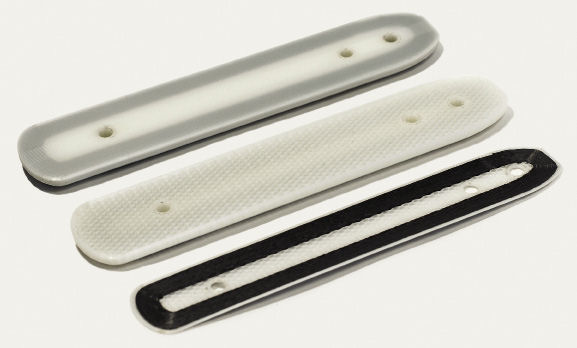 An example of an automotive, aerodynamic wing “footing,” 3D-printed in layers of nylon and continuous-strand carbon fiber. The company says that parts made with its continuous-carbon-fiber approach are up to 20 times stiffer and five times stronger than ABS plastic, and have a higher strength-to-weight ratio than 6061T6 aluminum. Image courtesy of MarkForged.
An example of an automotive, aerodynamic wing “footing,” 3D-printed in layers of nylon and continuous-strand carbon fiber. The company says that parts made with its continuous-carbon-fiber approach are up to 20 times stiffer and five times stronger than ABS plastic, and have a higher strength-to-weight ratio than 6061T6 aluminum. Image courtesy of MarkForged.Also this year, newly formed Graphene 3D Lab has been working to produce graphene-infused filament in partnership with Lomiko Metals as the source for graphite. The initial goal is to use this material along with conventional polymers to produce 3D-printed functional electronic devices.
Choose Wisely
Not all materials work on all systems. Quality is really important, and things can get complicated fast. Whatever the initial structure and chemistry of the raw material, the physical properties of a final part still depend on the sum total of the approach, equipment, material, operational settings and CAD file manipulation. But, developments that today seem really out-there may be main-stream next year: Work is underway on materials derived from, or composited with, straw, clay, potatoes, beeswax, soybeans, seaweed, silk and linen, for example.
For users inclined to roll their own, filament extruders are now available from Ewe Industries, FilaFab and Legacy (open-source). And who knows what materials will accompany Autodesk’s Spark resin-based system announced in May?
With so many choices, it pays to ask system manufacturers, service bureaus and material providers to explain all the pros and cons.
More Info
- 3D Ink
- 3D Systems
- Advanced Laser Materials
- Arevo Labs
- Arkema
- Autodesk
- B9Creations
- Bolson Materials
- Bucktown Polymers
- ColorFabb
- CRP Technology
- DeltaMed
- DWSLab
- Emerging Objects
- Envisiontec
- EOS
- Ewe Industries
- Fenner Drives
- Filafab
- FormLabs
- FSL3D
- Graphene 3D Lab
- Groupe Gorgé
- Hardcotton
- Legacy
- Lomiko Metals
- MadeSolid
- MakerJuice
- MAKEX
- MarkForged
- Old World Labs
- Peachy Printer
- Prodways
- Royal DSM/Somos
- Spot-a-Materials
- Stalactite 102
- Stratasys
- Taulman3D
- Tethon3D
- Uncia 3D
Subscribe to our FREE magazine, FREE email newsletters or both!
Latest News
About the Author
Pamela Waterman worked as Digital Engineering’s contributing editor for two decades. Contact her via .(JavaScript must be enabled to view this email address).
Follow DE





